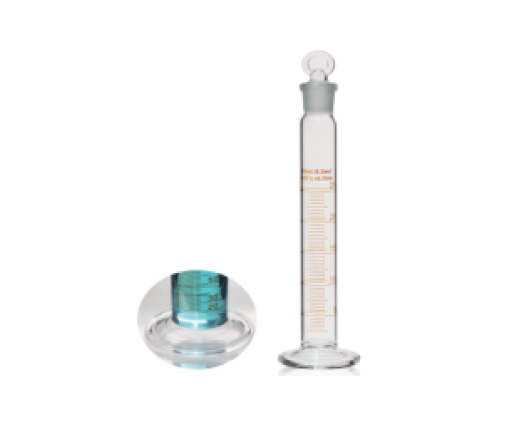In the grand tapestry of scientific exploration, measuring cylinders serve as the unsung heroes, akin to the meticulous hands of a watchmaker, precision guiding each movement. These vital instruments, designed with graduated markings, facilitate the accurate measurement of liquid volumes, establishing a cornerstone for experiments and processes across various scientific disciplines. Their applications span an impressive spectrum—from chemistry and biology to engineering and culinary arts—revealing the multifaceted role they play in both academia and industry.
At their core, measuring cylinders embody the essence of precision. Each graduated mark is meticulously crafted, representing a quantitative leap in understanding the physical properties of fluids. Much like the engraved lines on a musician’s score, these increments guide the researcher towards a harmonious interpretation of experimental data. In chemistry laboratories, measuring cylinders are indispensable when concocting solutions where precision is paramount; they ensure that reagents mingle in exact proportions, fostering reactions that yield reliable results. Without these instruments, the intricate dance of molecular interactions would become a chaotic affair, mired in the ambiguity of approximations.
Furthermore, measuring cylinders are not merely confined to the realm of chemistry. In the biological sciences, these cylinders are utilized to measure liquid volumes that can determine vital experimental outcomes. For instance, dilution series, a common technique in microbiology and biochemistry, rely on the accuracy of volume measurements to ascertain concentrations of substances. The act of diluting, with extracting droplets with the finesse of an artist’s brush, showcases the cylinder’s role in creating faithful replicas of real-world scenarios in vitro, offering insights into cellular mechanisms and organism behaviors.
Moreover, in the expansive field of engineering, measuring cylinders find their niche within fluid mechanics and hydraulics. Engineers harness these instruments to gauge the volumes of fluids in systems, from drainage calculations to the design of piping networks. The critical task of ensuring that fluid flow is both efficient and safe hinges upon accurate measurements. Here, measuring cylinders become symbolic of the precision mechanics of a well-oiled machine, where every drop counts and any error could lead to catastrophic failures. Their ability to withstand various chemical interactions and temperature fluctuations further enhances their utility, mirroring the resilience required within engineering practices.
Curiously, the culinary arts also exploit the unique capabilities of measuring cylinders. Culinary artists, much like alchemists, blend ingredients to create gastronomic masterpieces, employing these transparent vessels to ensure culinary accuracy in their recipes. When crafting the perfect potion—be it a sauce, emulsion, or infusion—the precision provided by a measuring cylinder eliminates the chaos of guesswork. A tablespoon of precision often yields a tablespoon of spectacular flavor; thus, the measuring cylinder bridges the gap between artistic expression and scientific exactitude.
In addition to their practical applications, measuring cylinders possess an alluring aesthetic. The crystalline clarity of glass cylinders, or the robust nature of calibrated plastic variants, captures the light in a way that evokes the beauty found in the natural sciences. When filled with colorful solutions, they transform into vivid receptacles of knowledge, enticing the observer with the promise of discovery. This visual appeal intertwines with the scientific process, where every measurement taken is not just a number, but an entry into the grand narrative of inquiry.
Moreover, the design of measuring cylinders underpin their functionality, with a wide base ensuring stability, thus reducing the likelihood of spillage—a key consideration when working with valuable or hazardous substances. The narrow and elongated shape facilitates ease of pouring, while the graduated markings are strategically placed for visibility. This ergonomic design renders the measuring cylinder not only an instrument of measurement but also a harmonious tool that reflects both form and function.
It is essential to consider the limitations and best practices associated with the use of measuring cylinders. Though commonly reliable, users must be vigilant of factors such as parallax error—an optical illusion that can distort the observation of liquid levels. Ensuring that the eye is level with the meniscus, the curve formed at the surface of a liquid, is crucial for obtaining accurate readings. This quest for accuracy calls to mind the discipline of a tightrope walker—a balance between precision and understanding is vital to avoid falling into error.
Additionally, calibration plays a pivotal role in maintaining the integrity of measurements. Regular verification against a standard ensures that the cylinder remains a trustworthy ally in scientific pursuits. Such diligence fosters a culture of accuracy, where every experiment is performed with the confidence that the tool wielded is not merely accurate but also calibrated for excellence.
In conclusion, the measuring cylinder stands as a testament to the art and science of measurement. From the laboratory to the kitchen, from fluid dynamics to biological assays, its applications are as diverse as they are integral. The precision it offers allows for a meticulous exploration of the physical world, where a single milliliter can alter outcomes and redefine understandings. Thus, the humble measuring cylinder transcends its simplicity; it becomes an emblem of the deep and intricate relationship between science and artistry in the pursuit of knowledge and innovation.










